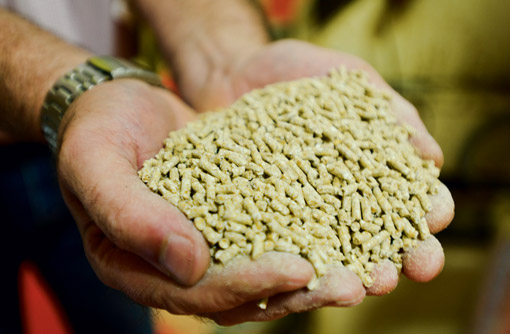Bird health challenged by poorer feed ingredients

Variable wheat quality and ration balancing could be having a dramatic impact on poultry health and productivity this year, as Olivia Cooper discovers
Cereal producers have bemoaned last year’s poor quality harvest, with low bushel weights causing significant yield losses and financial penalties.
But while bushel weights aren’t directly correlated to the energy content of wheat, there is evidence that this season’s wheat quality is adversely affecting broiler performance.
According to Sam Smyth, poultry nutritionist at Devenish Nutrition, feed conversion ratios increased by an average of three to eight points over the autumn, with increased reports of enteritis and deteriorating litter conditions. “I don’t think you can say that this is a direct consequence of new season grain alone, but it has compounded some of the other issues out there.”
With broilers under great pressure to maximise feed intakes and growth rates, their gut health is already on a knife-edge, and any change in stress factors – nutritional or otherwise – could have a noticeable effect on performance, he adds. “There is a lot of interaction between nutrition, health, environment, temperature and humidity.
“All these variables make it very difficult to make broad scale recommendations on nutrition. Feed makes up an ever-increasing proportion of production costs, so it’s very important to get the right balance of energy, protein, amino acids, minerals, vitamins, fatty acids and so on. Diets should be individually formulated to reflect the raw materials being used, allow the mill to produce the feed to a satisfactory standard and also meet the nutrient requirements of the birds.”
Creating an effective ration is not just about the right nutrient balance on paper – compounders also need to consider the feed’s physical quality, durability and grist to maximise feed intakes, digestibility and gut health, says Mr Smyth. “You can have the best diet in the world, but it’s no good if the birds can’t eat enough of it or don’t digest it effectively.”
If a diet’s nutrient content is variable, the birds will eat more to try and balance their intakes, but that causes an excess of the other constituents. The birds then excrete excess nutrients, causing increased water intake and wet, protein rich litter, leading to problems like hock burn and footpad dermatitis. “It’s a vicious cycle if you have enteric problems, as the birds aren’t absorbing the food they eat, so they eat more to address the imbalance, which makes it even worse.”
Early access to feed is essential to kick start development of the gut and immune system, he adds. “The longer the delay, the greater the negative impact on lifetime health and performance. If birds are under immune challenge, essential nutrients are diverted from growth to help support the immune system. In addition, birds often eat less during this period.”
To try and combat the problems of last year’s poor harvest, some companies have been considering alternative ration strategies. “Options may include reviewing the use of enzymes to further improve the digestibility of the feed, as well as the nutrient specification of feed, which has resulted in better FCRs in some cases.”
Other additives, like organic acids, fatty acids, probiotics and fimbria blockers can also complement gut health.
This season, mycotoxin binders could be more valuable than ever, with the wet harvest increasing the risk of mycotoxins in feed. “There are a huge number of mycotoxin species, and we need a lot more research into the interactions between them,” says Dr Swamy Haladi, global technical manager of the mycotoxin team at Alltech.
In UK trials, more than 60% of feed samples tested positive for DON, with 45% carrying fumonisins, and nearly 30% penicillium mycotoxins. “There are between one and five mycotoxin species present in 83% of samples tested – we are massively under-estimating the challenges.”
Alltech is carrying out extensive research into the interaction between different types of mycotoxin, with some strains proving significantly more toxic than others. “We’re never going to be able to test for them all in one go, but we can now identify 38 different mycotoxins – and where there is a problem on farm we can carry out a test a and develop an integrated plan.”
Mycotoxins kill off beneficial microflora in the gut, damage intestinal villi, reduce liveweight gain and depress the immune system, says Dr Haladi. “When fed mildly contaminated grain (2ppm of DON), birds took three days longer to reach market weight. But when combined with Mycosorb (a mycotoxin binder), it almost completely eradicated the problem. However, you need an holistic approach – simply adding Mycosorb to feed won’t work as well as an integrated plan.”
* This article is based on presentations given to a Datapoul gut health conference.
